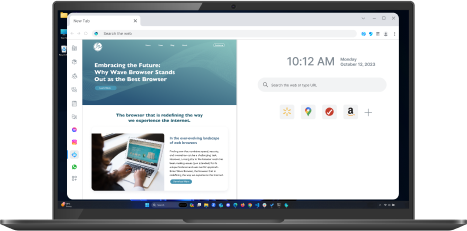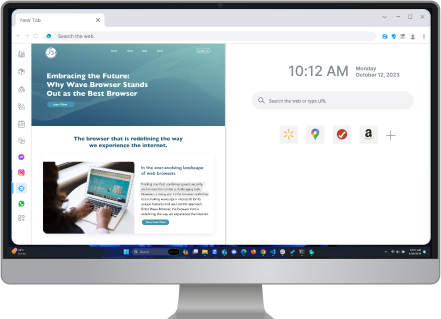How to Check Your Browser History on Any Device
Table of Contents

Your browser history tracks the websites you access and records your online activity, applicable to both mobile and desktop devices. This data is saved by your web browser to enhance the speed of future and related searches. However, privacy concerns arise for some individuals who worry about the excessive amount of information retained online.
Understanding how to view, modify, and delete your internet history is essential for maintaining safe browsing practices and improving browser performance.
Learn how to manage your browser history, handle private browsing sessions, and control stored website data with easy-to-follow steps across all major platforms.
What Is Internet Browser History?
Browsing history, also called search history, is the list your web browser keeps of the websites you visit. Each time you go online, the browser adds a record. This record often shows the pages you went to and when you saw them. But when you go online, these records stay on your device. This can create privacy risks.
There are some good reasons to keep your browsing history:
- Pages load faster;
- You get better search suggestions;
- Your old data is still there if you need it.
However, that same information can become a privacy risk. If someone gains access to your browser, they could view your entire browsing and search history—potentially exposing sensitive data. To help protect your privacy, web browsers like Microsoft Edge and Chrome offer features that let you delete or manage your browsing data more effectively.
How to View Browser History on Desktop
Navigating your browser history on a desktop is easy. Different web browsers like Google Chrome, Safari, and Mozilla Firefox let you open your browsing logs right from the menu bar or by using simple shortcuts.
For instance, you can use keyboard shortcuts like Ctrl + H on a Windows PC or Command + Y on a Mac to quickly open the history panel in most browsers. From there, you can view your browsing history, search through saved websites, review downloaded files, or delete any data you no longer need from your laptop.
1. Browser History in Safari
Safari makes it easy to view and clear your browsing history, whether you use a Mac, iPhone, or iPad.
On the Mac, you just open Safari and go to the history menu. Click on “Clear History.” Pick how far back you want to go, then confirm. Safari will take out your browsing history. It clears the cache, cookies, and your list of files all at once. Make sure you want to do this, as Safari does not ask for extra confirmation.
On an iPhone or iPad, begin by tapping the book icon in Safari. Next, tap the clock to see all your browsing history. To remove single items, swipe on them. If you want to remove everything, tap “Clear” and pick the time you want to clear. Safari helps your device stay private and may run faster when old browsing history is gone.
If you want to keep your history managed on all your devices, Safari has simple and good built-in tools. They help with what you need for easy browsing.
2. Browser History in Chrome
Google Chrome makes it simple to handle your browsing history across all your devices.
To delete Chrome browsing history on your desktop, open Chrome and click the three-dot menu icon in the top-right corner. Select “History,” then click “History” again in the submenu. You’ll see a full list of sites you’ve visited, which you can search or delete individually.
To remove a large portion of your history, click “Clear browsing data” in the left-hand menu. Ensure the “Browsing history” box is checked, select your desired time range, then click “Clear data.” This method works on both Windows PCs and Macs.
How to See Browser History on Mobile
Mobile access to your browser history should be easy and quick. No matter if you use Safari, Chrome, or some other browser, these steps do not take much time or effort.
On Android devices, open your browser app to see the history menu. For iPhone or iPad users, open Safari, then tap the "book" and the "clock" icons to look at your past searches. People can edit or remove browsing data on mobile devices fast, often with just a few taps. In the next sections, you can read simple guides for Android and iOS.
1. Browser History on Android
Checking your browser history on Android is easy, especially if you use Google Chrome.
When you open Google Chrome, tap the three dots at the top right to open the menu. Pick “History.” Here, the app will show you your recent browsing. If you want to delete only some things, tap the X next to whatever you do not want. If you want to remove everything, tap “Clear Browsing Data.” Make sure you check the right box and confirm that you want to clear the browsing data.
Android phones also use your Google account to keep track of app activity and browser usage. This helps you get to your data on any device, but you should still clean it up sometimes for privacy. To do this, use Chrome’s option “Clear All” in the browsing data settings. This way you protect your data and keep things safe.
If you are using another browser app on Android, it also has a place in settings to check your browsing history and delete what you want. Most browsers now have easy to use privacy dashboards that let you delete your browsing or app activity without giving up any other features.
2. Browser History on iOS
Viewing and managing your browser history on iOS devices, like an iPhone or iPad, is easy with Safari or Google Chrome.
For Safari users, you just tap the book icon at the bottom, then tap the clock sign to see your browsing history. To delete one item, swipe on it and tap “Delete.” If you want to clear more of your browsing data, hit “Clear” at the bottom and pick the time frame you want. Safari is good for privacy, so it helps you clean up your browsing info quickly and well.
If you use Google Chrome on iOS, this is also simple. Open Chrome, tap the three dots at the bottom, and go to “History.” There, you can delete single items by tapping the X, or you can pick “Clear Browsing Data” to delete a lot at once. You can use the privacy dashboard to see Google searches you did on other devices connected to your Google account.
When you want to keep your browsing private without using incognito mode, both Safari and Chrome allow you to delete your browsing activity easily. No matter which browser you choose, clearing your browsing data is quick and straightforward.
How Do I Delete My Browsing History?
To clear browsing history, go to your browser settings. In most browsers:
- Look for "Privacy" or "History".
- Choose “Clear browsing data” or “Delete history,”
- Select your desired time range, and confirm the action.
This process ensures all tracked activity is removed from your device.
Can you Recover Browsing History on a Phone or Computer?
Lost browsing history can often be found again. This depends on your device and your browser settings.
On computers, if you have synced your browser with your Google account, your old websites and download history can be accessed. Chrome history saves your browsing data by linking it with your Google account, even across different devices, and not just on a paid subscription. You can also use third-party recovery tools to try to get back deleted browsing history if it is missing.
On phones, you have a few of the same options.
If you use Android, your app activity and browsing data can be saved automatically with your Google account.
iPhones let you find your Safari browsing data in system backups. While different browsers may work in different ways, syncing your browsing data and using recovery tools are often the best ways to find lost history if it goes missing.
Doing regular backups for all your devices also makes sure your browsing logs and download history will be there if you ever need them again.
Surf with Ease, Speed, and Security!

Download Wave Browser for a seamless online experience like never before. Try it now!

























